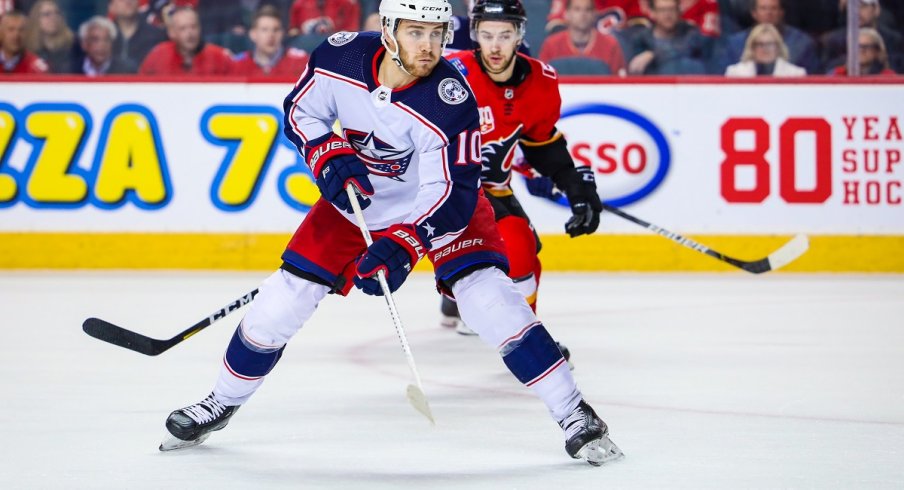When Alexander Wennberg was drafted by the Columbus Blue Jackets with the 14th overall pick in the 2013 NHL Draft, he was selected as a current and future center.
Through six seasons and over 400 regular-season games in Columbus, the Swede has played primarily down the middle, his defensive prowess serving as justification for his roster spot as his offensive production has disappointed for the better part of three consecutive seasons. When Wennberg was activated off IR in late February after missing 12 games, John Tortorella and his coaching staff employed a new strategy to jumpstart the seldom-appreciated Wennberg, 25: moving him from center to the wing.
It was a noteworthy strategy, and with the season on pause, I thought it would be as good a time as ever to try to explain why Tortorella would come to this conclusion and to better understand if his newly-shaped lineup had proven to be a good idea in the five-game sample size after his activation from IR and before the season was postponed.
Obviously, in such a small sample, it's difficult to glean too much about the results of the team, who was about to embark on their annual Western-Canada trip. An embarrassing 5-0 home loss to the Minnesota Wild was followed up with a crucial win over the Vancouver Canucks, a heart-wrenching overtime loss in Calgary, a frustrating night in Edmonton (where they outplayed and outshot the Oilers but lost 4-1), and ultimately returning home to Nationwide Arena by triumphantly beating the Canucks for the second time in a week. So, a pedestrian 2-2-1 stretch.
But for Wennberg, with a 5-17-22 stat line in 57 games as of the NHL's pause, it signified a rather significant roster change that moved him out of his familiar center spot to the left-wing, where he'd play alongside center Pierre-Luc Dubois and Emil Bemstrom.
Wennberg was never revered for his effectiveness in the faceoff circle, but he's proven to be a reliable defensive player over the course of his career. The Blue Jackets, even with a fully healthy lineup, aren't exactly loaded down the middle of the ice. Dubois has established himself as a top-six center, and Boone Jenner has done well to adjust his game from the wing, where he's more natural, to center. Aside from that, the Blue Jackets have leaned on a rotating cast of characters in an injury-riddled season, including (along with Wennberg) Riley Nash, Kevin Stenlund, and recently, Devin Shore. Moving Wennberg away from an already-thin position is notable.
Center is a demanding position. In the defensive zone, a center serves as a third-defenseman, marking up (alongside his two defensemen) against an opposition's three forwards (this is putting it simply). In transition, it's often presumed that a center is the first-man back to help defensively, and the center must be careful not to be caught cheating for offense while still in the defensive zone, whereas wingers can be a tad more casual (though I'm sure a winger wouldn't say this in front of his head coach).
Wennberg's lack of offense in recent years has been excused by his diligence on the defensive side of the puck. By placing him on the wing, Tortorella is gambling that his team can find a way to (1) kickstart his offensive game and (2) withstand a further lack of depth at the center position elsewhere in the lineup.
Per NaturalStatTrick, Wennberg's newly constructed line had positive possession numbers in all five of their games together at 5v5, and though Wennberg only tallied one 5v5 point (the below secondary assist), his line showed well in their short audition (Note: he actually added an assist in the prior game as well, but it was 4v4 alongside Gus Nyquist and in the final minute of the Oilers loss).
At least, Tortorella thought so. Per LeftWingLock, which aggregates such data, no line played more at even strength than Wennberg-Dubois-Bemstrom in the past three games. Playing alongside two of the more offensively dangerous players in the lineup, the coaching staff clearly believed that playing Wennberg with offensive weapons, while reducing his (theoretical) defensive responsibilities, would jumpstart his game. It's hard to say that it worked - or that it didn't, due to such a small sample - but it's an interesting strategy that would have been fascinating to monitor had the season progressed as scheduled.
Instead, we're in it for the long haul, and when hockey eventually does return (and the Blue Jackets will be healthier), it's unlikely that this same line will be restored.
Wennberg is an interesting case study. He still clearly has NHL talent, as a triumphant World Championship in the summer of 2019 saw him score 10 points in six games. Owed $4.9M per season through 2022-23, the Blue Jackets are still hoping to squeeze any lemonade out of his game. Moving him to the wing may be the last strategy that the club can employ to see desired results.
